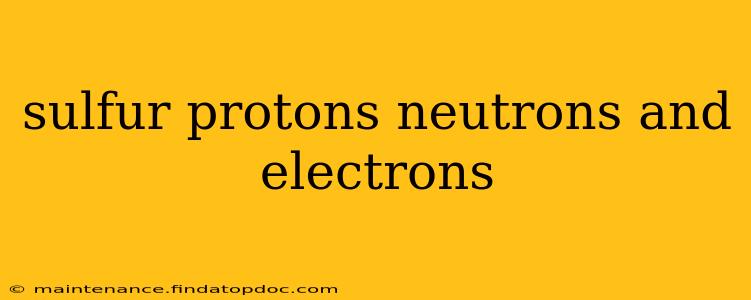Sulfur, a vibrant yellow nonmetal, plays a crucial role in various biological and industrial processes. Understanding its atomic structure, particularly the number of protons, neutrons, and electrons, is key to comprehending its chemical behavior and properties. This comprehensive guide will delve into the specifics of sulfur's atomic composition, addressing common questions and misconceptions.
What are the protons, neutrons, and electrons in sulfur?
Sulfur's atomic number is 16, meaning a neutral sulfur atom contains 16 protons. The number of protons defines an element; all sulfur atoms have 16 protons. To maintain electrical neutrality, a neutral sulfur atom also has 16 electrons. These electrons orbit the nucleus in various energy levels or shells.
The number of neutrons, however, varies. This variation leads to different isotopes of sulfur. The most common isotope, sulfur-32 (³²S), contains 16 neutrons. Other stable isotopes exist, such as sulfur-33 (³³S) with 17 neutrons and sulfur-34 (³⁴S) with 18 neutrons. The total number of protons and neutrons determines the mass number of the isotope.
How many electron shells does sulfur have?
Sulfur's 16 electrons are distributed across three electron shells. The first shell holds a maximum of two electrons, the second shell holds up to eight, and the third shell holds the remaining six. This electron configuration (2, 8, 6) influences sulfur's chemical reactivity, as it readily gains or shares electrons to achieve a stable octet (eight electrons) in its outer shell.
What is the atomic mass of sulfur?
The atomic mass of sulfur isn't a whole number because it represents the weighted average of the masses of all its naturally occurring isotopes. The standard atomic weight of sulfur is approximately 32.06 atomic mass units (amu). This reflects the abundance of the different sulfur isotopes.
How is the number of neutrons in sulfur determined?
The number of neutrons in a sulfur atom is determined by subtracting the atomic number (number of protons) from the mass number of the specific isotope. For example:
- Sulfur-32 (³²S): Mass number (32) - Atomic number (16) = 16 neutrons
- Sulfur-34 (³⁴S): Mass number (34) - Atomic number (16) = 18 neutrons
This calculation applies to all isotopes of sulfur.
What are some common uses of sulfur?
Sulfur's unique properties lead to its wide applications across various industries. It's a crucial component in the production of sulfuric acid, a vital industrial chemical used in fertilizer production, metal processing, and countless other applications. Sulfur is also used in the vulcanization of rubber, providing strength and durability. Furthermore, it plays a vital role in the production of various pharmaceuticals and other chemicals.
Conclusion
Understanding the atomic structure of sulfur, including its protons, neutrons, and electrons, provides a foundation for appreciating its diverse applications and chemical behavior. The variations in neutron numbers, resulting in different isotopes, further contribute to the complexity and importance of this element in our world. This detailed explanation hopefully clarifies the core concepts and provides a solid base for further exploration.
